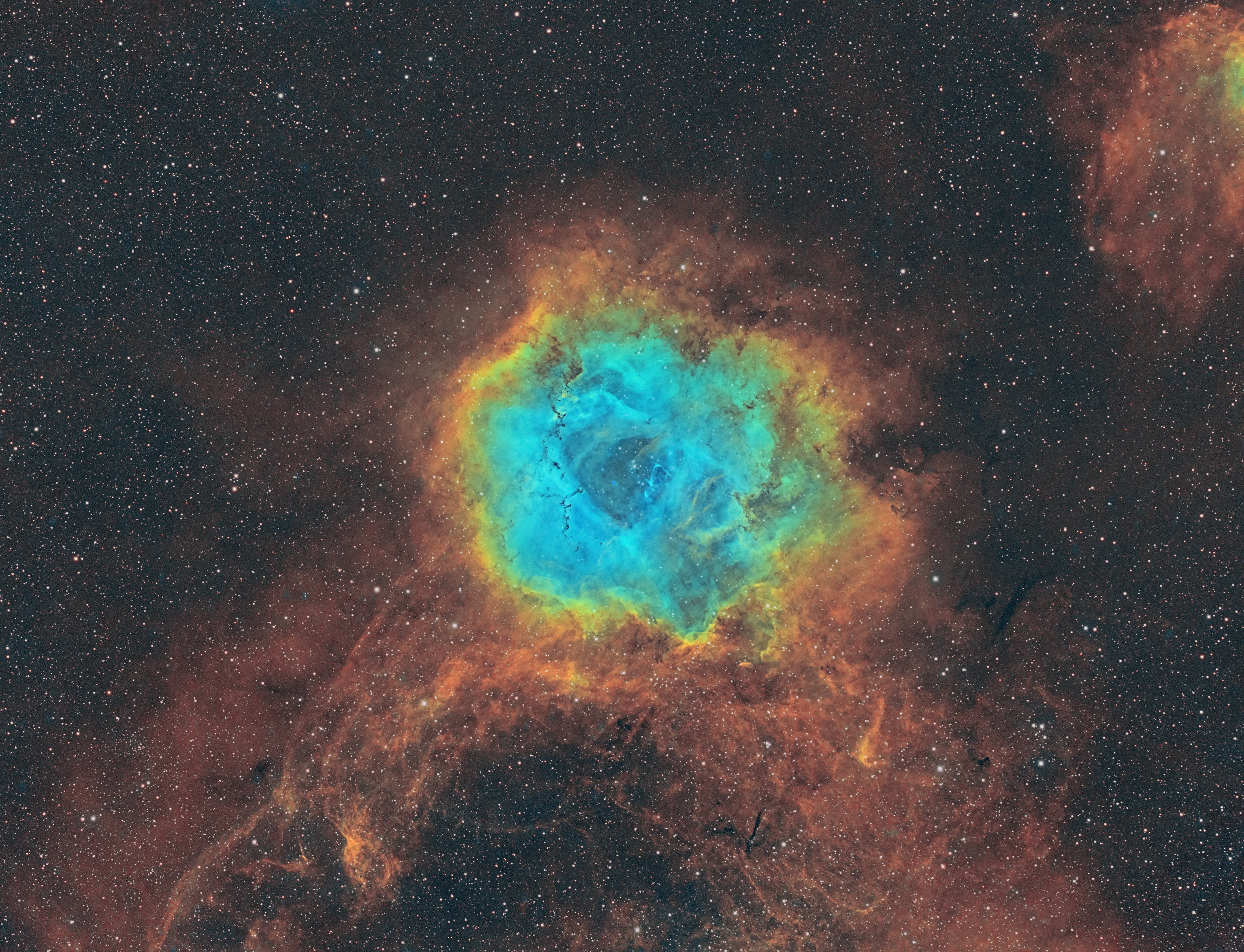NGC 2244 - RosettennebelNGC 2244 - Rosette Nebula
 Fahre mit der Maus über das Bild um es zu vergrössern
Move the mouse over the image to enlarge it
Fahre mit der Maus über das Bild um es zu vergrössern
Move the mouse over the image to enlarge it
Der Rosettennebel (auch als Caldwell 49 bekannt) ist eine H II-Region in der Nähe eines Endes einer riesigen Molekülwolke in der Monoceros-Region der Milchstraßengalaxie. Der offene Sternhaufen NGC 2244 (Caldwell 50) ist eng mit dem Nebel verbunden, wobei die Sterne des Haufens aus der Materie des Nebels entstanden sind.
Der Komplex hat die folgenden Bezeichnungen des Neuen Allgemeinen Katalogs (NGC):
- NGC 2237 - Teil des Nebelgebiets (wird auch zur Bezeichnung des gesamten Nebels verwendet)
- NGC 2238 - Teil des Nebelgebiets
- NGC 2239 - Teil des Nebelgebiets (Entdeckt von John Herschel)
- NGC 2244 - Der offene Sternhaufen innerhalb des Nebels
- NGC 2246 - Teil des Nebelgebiets
Der Sternhaufen und der Nebel befinden sich in einer Entfernung von 5.000 Lichtjahren von der Erde und haben einen Durchmesser von etwa 130 Lichtjahren. Die Strahlung der jungen Sterne regt die Atome im Nebel an, so dass sie selbst Strahlung abgeben und der Emissionsnebel entsteht, den wir sehen. Die Masse des Nebels wird auf etwa 10.000 Sonnenmassen geschätzt.
Eine Durchmusterung des Nebels mit dem Chandra-Röntgenobservatorium hat das Vorhandensein zahlreicher neugeborener Sterne im optischen Rosettennebel und in einer dichten Molekülwolke ergeben. Insgesamt befinden sich etwa 2500 junge Sterne in diesem Sternentstehungskomplex, darunter die massereichen O-Sterne HD 46223 und HD 46150, die hauptsächlich für das Aufblasen der ionisierten Blase verantwortlich sind. Der größte Teil der laufenden Sternentstehungsaktivität findet in der dichten Molekülwolke südöstlich der Blase statt.
Zwischen den Sternen in der Blase ist auch ein diffuses Röntgenglühen zu sehen, das auf ein superheißes Plasma mit Temperaturen von 1 bis 10 Millionen K zurückgeführt wird. Dies ist wesentlich heißer als die 10.000 K Plasmen, die in HII-Regionen zu sehen sind, und wird wahrscheinlich auf die schockgeheizten Winde der massereichen Sterne vom Typ O zurückgeführt.
Quelle der Beschreibung: WikipediaThe Rosette Nebula (also known as Caldwell 49) is an H II region located near one end of a giant molecular cloud in the Monoceros region of the Milky Way Galaxy. The open cluster NGC 2244 (Caldwell 50) is closely associated with the nebulosity, the stars of the cluster having been formed from the nebula's matter.
The complex has the following New General Catalogue (NGC) designations:
- NGC 2237 – Part of the nebulous region (Also used to denote whole nebula)
- NGC 2238 – Part of the nebulous region
- NGC 2239 – Part of the nebulous region (Discovered by John Herschel)
- NGC 2244 – The open cluster within the nebula
- NGC 2246 – Part of the nebulous region
The cluster and nebula lie at a distance of 5,000 light-years from Earth and measure roughly 130 light years in diameter. The radiation from the young stars excites the atoms in the nebula, causing them to emit radiation themselves producing the emission nebula we see. The mass of the nebula is estimated to be around 10,000 solar masses.
A survey of the nebula with the Chandra X-ray Observatory has revealed the presence of numerous new-born stars inside optical Rosette Nebula and studded within a dense molecular cloud. Altogether, approximately 2500 young stars lie in this star-forming complex, including the massive O-type stars HD 46223 and HD 46150, which are primarily responsible for blowing the ionized bubble. Most of the ongoing star-formation activity is occurring in the dense molecular cloud to the south east of the bubble.
A diffuse X-ray glow is also seen between the stars in the bubble, which has been attributed to a super-hot plasma with temperatures ranging from 1 to 10 million K. This is significantly hotter than the 10,000 K plasmas seen in HII regions, and is likely attributed to the shock-heated winds from the massive O-type stars.
Source of description: WikipediaAufnahmedetails Acquisition details
Frames:
Aufnahmedauer insgesamt: Total integration time: 9h 50m
Verwendete Ausrüstung Equipment used